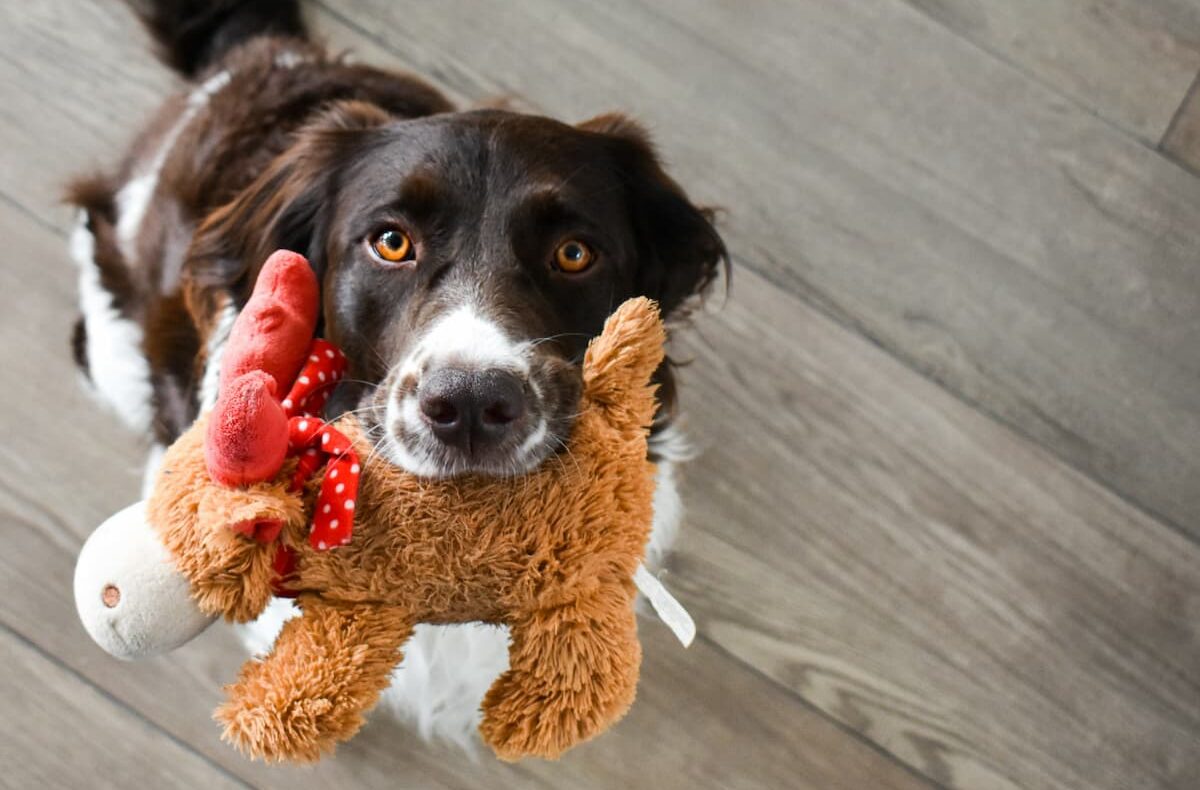Have you ever watched your furry companion wildly swing their favorite toy around with absolute glee?
It’s as if they’re in the middle of a canine tornado, dancing and twisting with all their might.
While it may seem like just a cute and peculiar display, there’s actually more to it than meets the eye.
This article will explore the reasons why dogs swing their toys.
The Surprising Reasons Behind Your Dog’s Playful Toy Swinging
Dogs are known for their playful nature, always eager to engage in various activities that bring them joy.
One fascinating behavior commonly observed in dogs is their tendency to swing their toys.
It may seem like a simple and random action, but there are actually surprising reasons behind this adorable behavior:
1. Release of Excess Energy
Dogs are bundles of energy, and swinging their toys is a way for them to release some of that pent-up energy.
Just like humans engage in physical activities to burn off excess energy, dogs instinctively turn to their toys to let off steam.
The swinging motion provides a physical outlet for their excitement, keeping them physically active and mentally stimulated.
2. Seeking Mental Stimulation
Dogs are intelligent beings, and like us, they need mental stimulation to keep their minds sharp.
Toy swinging provides them with a mentally enriching activity that keeps them happily engaged.
By moving their toys in this way, dogs are constantly testing their problem-solving skills.
They’re not just enjoying the physical act of swinging; they are also challenging themselves by calculating trajectory, speed, and even manipulating angles.
3. Mimicking Prey Behavior
Dogs are descendants of wolves, and their natural instincts often shine through in their behavior.
When a dog swings its toy, it could be mimicking the movement of prey in the wild.
Dogs have an innate drive to chase and hunt, and swinging their toy back and forth activates those instincts.
It’s their way of engaging in a mock hunting scenario, satisfying their natural prey drive in a safe and controlled environment.
4. Mimicking Pack Members
Dogs may also mimic their interactions with fellow canines.
When dogs swing their toys, it imitates the playful tugging and shaking that occurs during friendly wrestling matches among pups.
By engaging in this behavior, dogs create a sense of companionship, reinforcing their bond with their toy companions and also with us, their human companions.
5. Seeking Attention and Interaction
Dogs are social animals, and swinging their toys can be a way for them to seek attention and interaction from their owners.
When a dog swings their toy, it’s hard to resist joining in and playing along.
By swinging their toy, they are inviting you to engage in playtime, promoting a bond between you and your furry friend.
It’s their way of saying, ”Let’s have some fun together!”
6. Stress Relief
Just like humans have stress balls or fidget spinners, swinging their toys helps dogs release built-up anxiety or tension.
This behavior allows them to vent their frustration or excess energy in a constructive and enjoyable way.
So, the next time you catch your furry friend swinging their toy around, remember that they might be trying to find solace or alleviate their daily stresses.
7. Expressing Affection and Comfort
Dogs also thrive on affection and companionship.
You may have noticed that your pup swings their favorite toy when they’re feeling happy or content.
This behavior often serves as a way for dogs to express their love and comfort.
Swinging their cherished toy can provide a sense of security and reassurance, just like a child clutching their beloved teddy bear.
Tips to Improve Your Dog’s Toy Swinging Experience
Now that you know the benefits behind toy swinging, here are some tips and tricks to encourage and enhance your dog’s toy swinging experience, ensuring they have a blast while keeping them happy and healthy!
1. Choose the right toys: To get your dog excited about toy swinging, select toys that are durable and designed for interactive play.
Look for toys that are easy to grip and have different textures or squeakers to pique their interest.
Keep in mind your dog’s size and chewing habits when making your selection.
2. Engage in interactive play: Dogs often swing their toys when they are in a playful mood and want to interact with their human companions.
Set aside dedicated playtime each day to engage in interactive play with your dog.
Use toys like tug ropes or fetch balls to encourage toy swinging and create a fun bonding experience.
3. Create a swinging zone: Designate a specific area in your home or backyard where your dog can freely swing their toys without any obstructions.
Clear the space of any breakable items, furniture, or sharp edges that could harm your dog or damage their toys.
This will give them the freedom to swing their toys around without any worries.
Remember, when you observe your dog swinging their toys, don’t hesitate to join in on the fun!
Engage with them using their favorite toys, throw them for a game of fetch, or indulge in a gentle tug-of-war session.
The quality time you spend playing together not only strengthens your bond but also provides mental and physical stimulation for your furry friend.
So, the next time your dog swings their toys, decode their signals and respond with enthusiasm – they’ll absolutely love it!
FAQ
Q: Why do dogs swing their toys instead of just holding onto them?
A: Dogs, being descendants of wild wolves, still retain some of their ancestral instincts.
One of these instincts is the natural prey drive that makes them want to shake, toss, and swing objects that resemble prey.
It’s like a vestige of their hunting instincts coming through.
Q: Is it just about instinct, or is there more to it?
A: While the instinctual aspect certainly plays a significant role, there’s more to the story.
Swinging their toys around can be seen as a form of play for dogs.
Just like children throwing a ball back and forth to entertain themselves, dogs engage in this behavior to keep themselves entertained and mentally stimulated.
Q: Does the size or type of toy impact how a dog swings it?
A: Absolutely!
The size, shape, and texture of the toy can influence how a dog interacts with it.
Smaller toys might be easier to toss and manipulate, making them swing more frequently.
On the other hand, larger toys with different features may encourage different types of play, like gentle chewing or pouncing.
Q: Is there a particular reason dogs swing toys from side to side instead of just tossing them up in the air?
A: The side-to-side motion might seem a bit puzzling, but it’s actually related to how dogs perceive and interact with their surroundings.
By swinging their toys from side to side, they’re mimicking the natural movements of prey trying to escape.
This action allows them to engage more with their toys and stay engrossed in their playtime.
Q: Are there any benefits to this swinging behavior?
A: Definitely!
Swinging toys can be highly beneficial for dogs’ physical and mental well-being.
It provides them with an outlet for their energy, helping to prevent boredom and destructive behaviors.
Additionally, swinging toys around stimulates their coordination and reflexes, contributing to their overall agility.
Q: Should we be concerned if our dogs swing their toys too aggressively?
A: It’s important to monitor our dogs while they’re playing and ensure they don’t become obsessed or overly aggressive with swinging their toys.
If your dog becomes fixated on swinging to the point where it seems harmful or dangerous, it’s always a good idea to consult with a veterinarian or a professional dog trainer for guidance and support.
Q: What else we can do to encourage if our dogs swing their toys?
A: Providing dogs with a variety of toys that cater to their preferences is key.
Experiment with different textures, shapes, and sizes, and see what kinds of swinging behaviors your furry friend enjoys the most.
Playfully engaging with them and occasionally swinging the toys yourself can also help stimulate their desire to swing and keep their playtime exciting.
Q: Is there anything else we should understand about dogs swinging their toys?
A: Understanding our dogs’ behaviors and instincts is essential for building a strong bond with them.
While swinging toys may seem like a simple playtime activity, it serves a greater purpose for our canine companions.
So, next time you catch your dog in the act of swinging their toys around, embrace this precious moment and join in on the fun!
A Summation of Key Takeaways
So, next time your furry friend starts swinging their toys around, you can confidently say, “Ah, I know why you do that!”
It turns out our beloved canines have quite a few reasons for this playful behavior.
Whether they’re letting off some steam after a tiring day, satisfying their natural prey drive, or just showing off their impressive hunting skills, watching them swing those toys is always a fascinating sight.
As they indulge in this delightful activity, we are reminded of the incredible instincts and playful nature that make dogs such remarkable companions.
So, embrace the joy of watching your pup swing away, and keep spoiling them with those squeaky toys they love so much.
After all, life is always more entertaining with a happy and swinging canine friend by your side!












